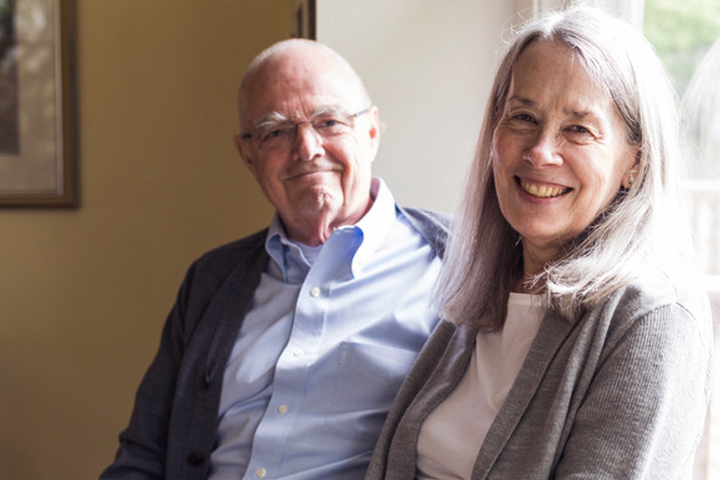Each Person Is a Statistic of One

- Long-term abdominal troubles finally diagnosed as stage IV pancreatic cancer
- Chemotherapy, followed by surgery
- More chemotherapy and radiation after surgery
- Mentoring other patients
I had abdominal symptoms for years before I was diagnosed with stage IV pancreatic cancer.
Occasionally I would have a feeling of abdominal inflammation, but I couldn’t pinpoint where exactly it was coming from. I just knew it wasn’t my stomach. I also could get a feeling of fullness for a few days, nausea, pain, and a whole-body fatigue. Usually it would last about three days and then go away, and these episodes could happen three or four times a year. Different doctors tested me for lupus, Crohn’s disease, irritable bowel syndrome, celiac disease, gall bladder disease, helicobacter pylori, and finally acid reflux. All these conditions were ruled out, but the symptoms were getting more frequent.
Finally my internist ordered an abdominal CT scan. The scan showed an 11 cm tumor in the tail of my pancreas that had grown into my spleen, a portion of my stomach, and the lining of my left kidney, and included many enlarged lymph nodes. On April 5, 2006, I was diagnosed with stage IV adenocarcinoma of the pancreas.
Trying an Unusual Treatment Plan
I first went to my surgeon, Dr. Mika Sinanan, then Chief of Surgery at the University of Washington Medical Center, to find out if he could remove the tumor. He did not want to operate on me because I was stage IV, when the cancer could possibly be all through my body. Although he did not have much hope for me, he would reconsider, depending on how effective chemotherapy was.
Shortly after my consult with Dr. Sinanan I went to Seattle Cancer Care Alliance (SCCA), where I met with my oncologist Dr. Sam Whiting (now directing oncology research at Calithera, a small biopharmaceutical company outside San Francisco, California). He was very supportive and never said I didn’t have a chance. He is a scientist and researcher, which really gave me hope, as I believed solid science would give me the best chance of survival.
At the time SCCA did not offer clinical trials for pancreatic cancer, but Dr. Whiting put me in a small study for stage IV patients to see if chemotherapy could shrink the tumor enough to make surgery possible. I was given a combination called GTX: gemcitabine (Gemzar), docetaxel (Taxotere) and capecitabine (Xeloda). After three months of treatment my tumor had shrunk 50 percent, and my CA 19-9 was in the normal range. Dr. Whiting ordered a PET scan, which showed very little activity in my pancreas and lymph nodes. I went back to Dr. Sinanan to plead my case for surgery. He was concerned that I would have tiny metastases in my abdomen, so surgery wouldn’t help me. He agreed to do a laparoscopic survey first to look for other metastases.
Surgical Removal of the Remaining Cancer
I had the surgery on August 4, 2006. Dr. Sinanan did not find any of the metastases he suspected were there, so he removed the tail of my pancreas, my spleen, part of my stomach, the covering of my left kidney, and some lymph nodes. He needed to leave one suspicious lymph node that was wrapped around my aorta, because it was dangerous to remove it. Dr. Sinanan told me that the surgery would be the worst thing I had ever been through, but I was home in four days. He had done a great job for me!
Dr. Whiting had told me that the pathology report found only 1 mm of viable cancer from the original tumor, but there was a small spot of cancer in one of the lymph nodes that was removed. Because of this and because my cancer had been so advanced, he recommended more chemotherapy. I had another three months of GTX, but Dr. Whiting was concerned about my cancer developing resistance to the drugs. I was switched to gemcitabine, oxaliplatin and erlotinib (Tarceva). I could handle only four cycles of the oxaliplatin, because for me it caused intense inflammation and a fleeting facial paralysis the day after infusion. At the time of my treatment several of the drugs I was given were experimental for pancreatic cancer, so safe and effective dosage and side effects were largely unknown. I stopped the oxaliplatin and continued with gemcitabine alone.
A year from surgery, a CT scan showed that the lymph node wrapped around my aorta had grown 1 cm, and a PET scan showed it was positive for cancer. I met with my radiation oncologist, Dr. Wui-Jin Koh, (then at UWashington, now Senior Vice President/Chief Medical Officer at the National Comprehensive Cancer Network), and added radiation therapy to my treatment. I had 26 fractions of radiation, coupled with nine weeks of chemotherapy with cisplatin and irinotecan. (Full doses of radiation are divided into smaller treatments called fractions, the series of treatments.)
When those treatments were completed I was exhausted and really needed to take a break to recover some energy. Fortunately, the follow-up CT scans kept coming back clear of cancer, so I took a chance and didn’t return to chemotherapy. For a couple of years, I was followed with CT scans and then was switched to MRIs and chest x-rays. In 2014 I was advised that I could stop the MRIs and switch to annual endoscopic ultrasounds to check for new lesions in my pancreas. My last EUS was in July 2017, when I had been 10 years cancer-free after end of treatment.
My family has an extensive history of many different kinds of cancer, so I went through genetic testing for mutations, but none was found. I will pursue further genetic testing if new mutations associated with pancreas cancer are discovered.
Finding Normalcy
Currently, I continue to watch my diet and get plenty of exercise. I need to take supplemental pancreas enzymes (pancrelipase) to help digest food, but otherwise I have a very normal life. I enjoy cooking, gardening, and family genealogy research, and I volunteer at the SCCA Guest Services Desk to help patients any way I can, and especially to show staff and patients that many patients can look normal and get their lives back. Most importantly, each one of us is a statistic of one.
Miggie tells her story in “Watch Me.”






